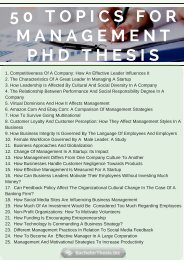PhD Thesis of Management Sample
Howdy! Check this article this is our professional PhD thesis of management sample, for more visit site and also you can download this sample. https://www.bachelorthesis.biz/management-thesis-writing-the-most-important-aspects/
Howdy! Check this article this is our professional PhD thesis of management sample, for more visit site and also you can download this sample. https://www.bachelorthesis.biz/management-thesis-writing-the-most-important-aspects/
Create successful ePaper yourself
Turn your PDF publications into a flip-book with our unique Google optimized e-Paper software.
PHD THESIS OF<br />
MANAGEMENT<br />
SAMPLE<br />
IMPLEMENTING EFFECTIVE RISK<br />
MANAGEMENT STRATEGIES
(2000) separates uncertainty and risk according to both factors<br />
Abstract<br />
The existence <strong>of</strong> uncertainty, complexity and ambiguity in the<br />
business environment promotes the need to establish a dependable<br />
risk governance. The use <strong>of</strong> Enterprise Risk <strong>Management</strong> (ERM) has<br />
also been considered as an effective method to attain good risk<br />
governance in order to deal with both upside and downside <strong>of</strong><br />
uncertainty and risk. ERM treats all <strong>of</strong> the risks holistically in order to<br />
achieve organization aims in volatile, normal and crisis situations. This<br />
<strong>PhD</strong> thesis will discuss issues related to the ERM implementation and<br />
how it has been adapted and implemented in the insurance market <strong>of</strong><br />
both India and UK. Mixed methods for research have also been<br />
employed coming from a qualitative stand point in order to explore<br />
research issues, consisting two surveys in both countries, with more<br />
than 50 interviews, as well as two case studies in the country’s<br />
insurance markets. The study revealed that an ambiguity is present<br />
when it comes to understanding all definitions <strong>of</strong> ERM, as well as the<br />
risks involved across both <strong>of</strong> the countries.<br />
Background <strong>of</strong> the Study<br />
In the current environment <strong>of</strong> business, corporations faced<br />
ambiguity, volatility, and uncertainty. Understanding uncertainty<br />
and risk has posed a number <strong>of</strong> challenges, and a clear<br />
distinction between uncertainty and risk is not clear. Ramir<br />
as measurability and immeasurability. It also highlights the<br />
impact <strong>of</strong> individual characteristic involved in the situation in<br />
terms <strong>of</strong> probability determination. Bernel (1998) also<br />
connected the importance <strong>of</strong> conditions to uncertainty where<br />
both measurement and rationality are vital to the process <strong>of</strong><br />
decision making.
Research Focus<br />
The currently existing regulations in the financial industry require a<br />
high level <strong>of</strong> transparency among institutions. Terrorist attacks, cyber-<br />
attacks, as well as increased volatility in the financial markets,<br />
including the bailout <strong>of</strong> the companies including the American<br />
International Group (AIG), in the recent past, leading companies to<br />
adopt their approaches beyond the Traditional Risk <strong>Management</strong><br />
processes. Just recently, ERM has introduced a shift from a separatist<br />
approach, converting to an integrated approach in order to include<br />
both risks in a holistic way, considering them as a way to implement<br />
effective risk governance in the field <strong>of</strong> financial industry.<br />
Recent financial issues have further raised concerns for exigency in<br />
order to deal with the challenges in a holistic way. The financial<br />
markets have also become more volatile, which means that the<br />
companies has to prepare accordingly in order to deal with such<br />
crisis and volatile situations. The adoption <strong>of</strong> a higher standard <strong>of</strong> risk<br />
governance through ERM practices may <strong>of</strong>fer plausible assurance to<br />
companies starting from the downside <strong>of</strong> challenges and risks,<br />
though the implementation will not be easy (Charter & Pucer, 2007).<br />
By adopting the Institutional Theory, the study will <strong>of</strong>fer comparative<br />
highlights on the specific aspects <strong>of</strong> ERM that is needed to<br />
understand risk governance completely. Unfortunately, a wide<br />
ambiguity involved in the understanding <strong>of</strong> ERM surfaced. The<br />
corporates are struggling in terms <strong>of</strong> the definition <strong>of</strong> ERM, including<br />
its goals and scope. Some definitions have also been proposed,<br />
without any requirements <strong>of</strong> standardization. As such, corporates<br />
cannot find the right strategies which can deal with uncertainties and<br />
risks in order to enhance risk governance.
Future Research<br />
Future research covering the jurisdiction at a local, industry, as well<br />
as international level would be enough basis for worthwhile effort.<br />
The understanding <strong>of</strong> the concept <strong>of</strong> ERM needs the completion <strong>of</strong><br />
more case studies which will help in understanding the institutional<br />
change, as well as its impact on strategies. There would be<br />
advantages that can be expected from presenting an international<br />
comparative study that compares ERM practices <strong>of</strong> local partnership<br />
and joint venture partnerships between India and the UK.<br />
References<br />
Bernel, G. (1998). The rise and introduction <strong>of</strong> the Chief Risk Officer:<br />
risk management at enterprise level. Applied Corporate Finance<br />
Journal, 12(3), 45-67.<br />
Charter, G. & Pucer, G. (2007). Investigating the evolution <strong>of</strong><br />
enterprise risk management in the insurance sector. Risk and<br />
Insurance Reports, 2(1), 23-34.<br />
Ramir, G. (2000). The relevance <strong>of</strong> disclosing risk factors in corporate<br />
yearly reports. UK Accounting Review, 34(2), 45-56.













